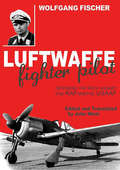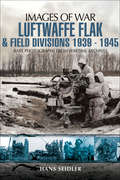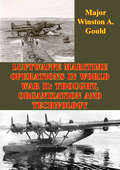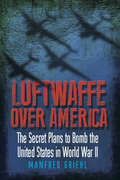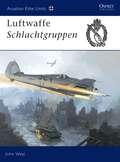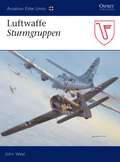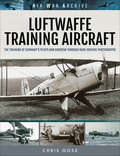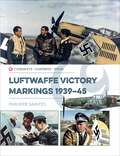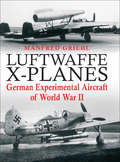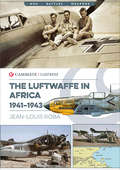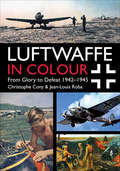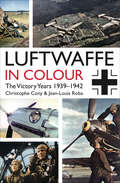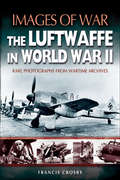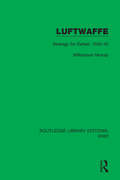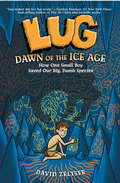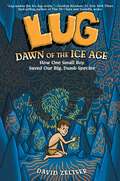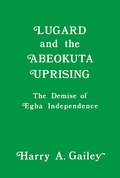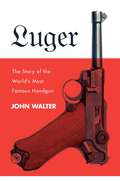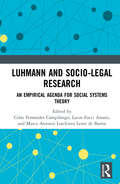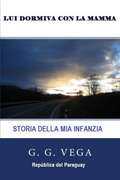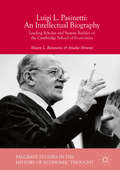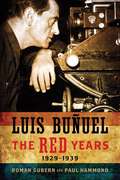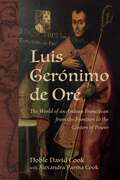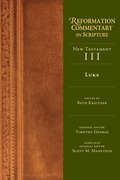- Table View
- List View
Luftwaffe Fighter Pilot: Defending the Reich Against the RAF and the USAAF
by Wolfgang FischerA Nazi Germany fighter pilot gives readers a bird's-eye view from the cockpit of aerial combat against the Allied forces in World War II. Within weeks of war being declared, Wolfgang Fischer had volunteered to join the Luftwaffe and spent nearly five of the succeeding six years of hostilities in uniform. During this time he was given a succession of postings varying from a long-range recce unit; as a decoder in a met office in occupied France; to a bomber squadron; and as a flying instructor, before joining a squadron of the famous Richthofen Geschwader in Italy, from where he was shot down in his FW 190 by Mustangs en route to Normandy. By now a Lieutenant, he survived to fly offensive rocket attacks over Gold Beach on D-Day, only to be shot down again on D+1, and captured and sent first to a hospital in the UK, then into captivity in the USA. He was finally repatriated in April 1946. His description of all these events is entertaining and well-written, ranging from comic to tragic. It is unique in flavor, giving a valuable insight into the undeniably typical lot of those serving in the air arm of the Third Reich. Expertly translated and edited by John Weal, this is a worthy accompaniment to Norbert Hannig's Luftwaffe Fighter Ace published by Grub Street in 2004.
Luftwaffe Flak and Field Divisions, 1939–1945
by Hans SeidlerFrom the outset of WW2, Grings Luftwaffe Flak units saw extensive fighting with their 2cm, 3.7cm and deadly 8.8cm anti-aircraft guns. By the time of Hitlers invasion of Russia, Luftwaffe ground forces had been expanded and were being used in both the army support and air roles.After initial success on the Eastern Front turned to stalemate and huge losses, Hitler ordered the raising of Luftwaffe Field Divisions to bolster the Army. These were initially under Grings command but in late 1943 were handed over to the Army and reorganized as standard infantry divisions (of three two-battalion rifle regiments) retaining Luftwaffe designations. The most famous was the elite Hermann Gring Divisions, which was reorganized as a Panzer Division.By 1944 there were no less than twenty-one Luftwaffe Field Divisions plus many similar regiments, fighting on all fronts. Of all German anti-tank weapons, the 8.8cm gun was the most feared and destructive.This book describes the evolution of this unique element of the Nazi war machine by means of clear text and superb images.
Luftwaffe Maritime Operations In World War II: Thought, Organization And Technology
by Major Winston A. GouldThe development of airpower can be traced to three key elements: thought, organization and technology. The Luftwaffe of World War II is no different. This paper will examine the Luftwaffe's thought, organization and technology as it pertains to maritime operations, or as the modern United States Air Force (USAF) calls it, Countersea Operations. These maritime operations will include direct support of the Kriegsmarine and independent Luftwaffe operations against the Allies. Luftwaffe thought will show that doctrinally the Luftwaffe was not as prepared for the maritime role its leaders thrust upon it, but flexibility and the application of the tenets of airpower provided the basis for adaptation. Also included will be an examination of the fierce rivalry between the Luftwaffe and Kreigsmarine senior leadership and how this interfered with the conduct of countersea operations. Luftwaffe organization during World War II provided a more than adequate basis for conducting the countersea campaign. The adaptability of the operational and support structure allowed the Luftwaffe to accomplish a variety of missions, even as their aircraft and weapons were proving deficient. Finally, the Luftwaffe was at the forefront of innovation in the field of aviation technology, including airframe and weapon development. Once again, interference by senior leadership and equipment teething problems combined with increasing Allied attacks cost the Luftwaffe precious time.
Luftwaffe Over America: The Secret Plans to Bomb the United States in World War II
by Manfred GriehlThe plans that Nazi Germany had to raid - and bomb - New York and the eastern seabord are revealed in this book. They were were based on the use of transoceanic aircraft planes, such as the six-engined Ju 390, Me 264 or Ta 400, but the Third Reich was unable to produce such machines in sufficient numbers. If the Soviet Union had been conquered, however, these plans would have become a reality. With the seizure of vital resources from the Soviet Union the Wehrmacht would have had enough fuel and material to mass-produce giant bomber aircraft: it was a near run thing. The collapse of the Wehrmacht infrastructure and the end of the Thousand-Year Reich ensured that plans for long-range remote-controlled missiles never got off the drawing board and were never manufactured. Manfried Griehl makes it clear that until the collapse, numerous secret research laboratories seemed to have worked in parallel seeking nuclear power and explosives. Only classified material held within British, French and American archives can prove whether these groups were close to perfecting small atomic explosives. But, without a shadow of doubt, Germany was far more technologically advanced by the end of 1944 that has been previously suspected.
Luftwaffe Schlachtgruppen
by John WealOne of the most important, and yet least publicised, components of the front-line Luftwaffe was the Schlacht, or ground attack, arm. This book details the Schlacht units who were in the thick of the fighting from the first day of the war until the last. They played a vital part in the heady successes of the early Blitzkrieg campaigns and went on to perform an equally essential role in the dark hours of last ditch defence and ultimate defeat. In between, they fought in all defensive battles: on the eastern front at Stalingrad, Kursk and Berlin; in the west, by night, over Normandy, the Ardennes and the Rhine.The color plate section of the book has profiles of the following, disperate aircraft:HS 123AHE 51BBf 109-4Bf 109EBf 109E-7HS 129BFw 190F-2Fiat Cr.42Fokker CV-EJu 87DAll of which were flown by this squadron. Also of note is the fact that this Ace pilot Hans-Ulrich Rudel was part of this distinguished unit.
Luftwaffe Sturmgruppen
by John WealThe 'storm troopers' of the Luftwaffe, the elite Strumgruppen units comprised the most heavily armed and armoured fighter interceptors ever produced by the Germans. Their role was to smash like a mighty fist through the massed ranks of USAAF daylight bombers. Only volunteers could serve with these elite units, and each pilot was trained to close with the enemy and engage him in extremely short-range combat, attacking from the front and the rear in tight arrowhead formations. In exceptional circumstances pilots would even ram their enemy. This book chronicles the brief, but violent, career of the Sturmgruppen during the dark days of 1944-45, employing first-hand accounts and rare archival photography.From the Trade Paperback edition.
Luftwaffe Training Aircraft: The Training of Germany's Pilots and Aircrew Through Rare Archive Photographs (Air War Archive)
by Chris GossFrom a retired RAF Wing Commander, an introductory guide to the aerial warfare training methods implemented by Germany for airmen during World War II. The often-unnoticed element in aerial warfare is the training, yet its value is beyond calculation. The Luftwaffe used a variety of aircraft in this fundamental role, with trainee pilots progressing from simpler, older machines to the more sophisticated, as well as heavier aircraft. Gradually airmen were introduced to newer, faster models that enabled them to experience, to some degree, the type of aircraft they would fly in combat. Recruits would initially spend six months at a Fliegerersatzabteilung or training depot, where the main emphasis was on drill and physical training, with introductory lectures on the principles of wireless operation and map reading. This would be followed by two months studying general aeronautical subjects, before being sent to elementary flying school. The various kinds of aircraft used for training depended upon the role each individual trainee would eventually undertake, from single-seat fighters to multiple-crew bombers or transports. In this, the Luftwaffe was also able to make use of captured enemy aircraft. It also established training units through the Occupied territories to enable its trainees to familiarize themselves with different conditions and terrain. In the less-pressurized environment of the training schools away from the front line, more care could be taken over photography, resulting in the author of this extensive study of the wide range of aircraft used for training by the Luftwaffe, being able to assemble such a fine collection of excellent images.
Luftwaffe Victory Markings 1939–45 (Casemate Illustrated)
by Philippe SaintesA fully illustrated overview of the Nazi German Air Force&’s victory markings on their day & night fighter aircrafts in World War II. This book provides an overview of the victory markings painted on the fins and rudders of the planes of the German day fighter and night fighter aircraft between 1939 and 1945, and demonstrates how these were applied in reality through the profiles of nineteen pilots, including some of the most emblematic pilots of the Luftwaffe: Hans Troitzsch, Johannes Gentzen, Frank Liesendahl, Wilhelm Balthasar, Otto Bertram, Joachim Müncheberg, Karl-Heinz Koch, Kurt &“Kuddel&” Ubben, Felix-Maria Brandis, &“Fiffi&” Stahlschmidt, Franz-Josef Beerenbrock, Heinrich Setz, Walter &“Gulle" Oesau, Max-Hellmuth Ostermann, Heinrich Bartels, "Fritz" Dinger, Martin Drewes, Egmont zur Lippe-Weissenfeld and Ludwig Meister.Praise for Luftwaffe Victory Markings 1939–45 &“For any and all who seek out photos of the German WWII victory markings adorning their aircraft, this book is simply a &‘must have&’.&” —Large Scale Planes &“Will be of great interest to modelers who want to put victory markings on a Luftwaffe fighter model.&” —AMPS Indianapolis &“Modelers seeking to put a finishing detail on their aircraft will find this book quite useful.&” —Historical Miniatures Gaming Society
Luftwaffe X-Planes: German Experimental Aircraft of World War II
by Manfred GriehlThis illustrated WWII history reveals the full range of experimental military aircraft that the Third Reich nearly flew into combat. From jet planes and high-altitude aircraft to radar-equipped fighters configured to deliver chemical weapons, numerous secret Luftwaffe planes reached prototype stage during the Second World War. Had these innovative aircraft made it into combat, the course of the war could have gone very differently. Renowned aviation expert Manfred Griehl explores these projects through an informative and fascinating selection of images, including numerous wartime photographs. Despite the Allied authorities' ban on research, countless aircraft were designed and tested by the Luftwaffe and German manufacturers before World War II. The research went ahead at secret evaluation sites in Germany, Switzerland, Sweden and the USSR. Though this work continued after the outbreak of war, many projects were never completed, often because the developers simply ran out of time. This definitive guide reveals the remarkable range of planes that the Third Reich failed to complete.
Luftwaffe in Africa, 1941–1943 (Casemate Illustrated #Cis0015)
by Jean-Louis RobaThis WWII history examines Nazi air force operations in Egypt and Libya with more than 100 rare wartime photographs. When Mussolini&’s army was defeated on the Libyan-Egyptian border at the beginning of 1941, Adolph Hitler had no choice but to send reinforcements to help his ally. The Luftwaffe deployed an air detachment, first to Sicily, then to North Africa. This volume examines the small expeditionary force, solely devoted to protecting Italian possessions in the Mediterranean and Middle Eastern theater. When General Erwin Rommel launched his Afrika Korps to the east, the Luftwaffe had to go on the offensive to cover the advance. As British air forces were strengthened, German High Command was obliged to send more aerial units into what it had initially considered a peripheral arena of the war. Losses in bombers and fighters were high on both sides. By the time the Allies landed in Morocco and Algeria at the end of 1942, the Wehrmacht&’s fate was sealed. The last German units capitulated in Tunisia in May 1943.
Luftwaffe in Colour: From Glory to Defeat
by Christophe Cony Jean-Louis RobaNearly four hundred photos documenting the last years of the Luftwaffe: &“If you&’re interested in unit history then this book is a must have&” (Britmodeller.com). A companion to the first volume of Luftwaffe in Colour, which covered the victory years from 1939 to Spring 1942, this book contains even more fascinating material on the machines of the Luftwaffe and the men who flew them as their fate took an increasingly grim path. Initially, the Luftwaffe ruled the skies, but eventually, they fought an increasingly futile war of attrition that, when combined with vital strategic mistakes in aircraft production, was its death knell. Despite this, the Luftwaffe produced the most successful air aces of all time. Among many remarkable images, we see one of the last Junkers 87 B-2 operational on the Eastern Front during the winter of 1942-1943; the huge BV 222 V-5 of Lufttransportstaffel in the port of Heraklion in late 1942; pilots in Tunisia in 1943; the aces Hans Philipp, Wolfgang Späte, and Heinz Schnaufer; and a vivid demonstration of the reversal in fortunes in 1944 as Allied bombers destroy 106 sites, engulfing them in fire at Schwäbisch Hall on German soil. In this painstakingly curated collection, the full detail behind the propaganda is once more revealed in rare color photographs.
Luftwaffe in Colour: The Victory Years
by Christophe Cony Jean-Louis RobaA photo-packed look at the men and machines of one of history&’s legendary air forces. This remarkable work explores the Luftwaffe as it truly existed day-to-day, underneath the propaganda of their own regime and the stories of their enemies. In Hitler&’s Germany, color photography was primarily co-opted for state purposes, such as the military publication Signal or the Luftwaffe&’s own magazine, Der Adler. But a number of men had cameras of their own, and in this painstakingly acquired collection, we can witness true life on Germany&’s airfields during the period of the Luftwaffe&’s ascendancy. Not only do we see famous planes such as the Me-109, Ju-87, and He-111, but the wide variety of more obscure types with which the Germans began the war. The array of Arados, Dorniers, Heinkels—not to mention elegant four-engine Condors—that were initially employed in the war are here in plain sight and full color, providing not only an insight into WWII history but a model maker&’s dream. Just as fascinating are the shots of the airmen themselves, along with their ground crews—full of confidence and cheer as they bested every other air force in Europe during these years, with the single exception of the RAF&’s Fighter Command in late summer 1940. But that was no big stumbling block to the Luftwaffe, which had bigger fish to fry in Russia and North Africa the following year. &“Both volumes [The Victory Years and From Glory to Defeat] are a fantastic addition to your aviation library. The reproduction quality is superb.&” —War History Online
Luftwaffe in World War II (Images Of War Bks.)
by Francis CrosbyWorld War Two Luftwaffe aircraft and their pilots have been a source of fascination and respect to aviation buffs since 1945. This book looks at all aspects of its operation in many World War II theaters. A great majority of photographs are unlikely to have been seen by the general public and they have been superbly reproduced directly from original negatives held by the Imperial War Museum.Lengthy captions describe the action portrayed in each photo and an introduction puts the Luftwaffe into its historical perspective.
Luftwaffe: Strategy for Defeat, 1933–45 (Routledge Library Editions: WW2 #16)
by Williamson MurrayThis book, first published in 1985, is an in-depth analysis of the Luftwaffe in the Second World War, using previously untapped German archives and newly-released ‘Ultra’ intelligence records. It looks at the Luftwaffe within the context of the overall political decision-making process within the Third Reich. It is especially valuable for its careful study of industrial production and pilot losses in the conduct of operations.
Lug, Dawn of the Ice Age
by David ZeltserA hilarious middle-grade novel about a misunderstood caveboy perfect for fans ofIce Age, Happy Feet, The Time Warp Trio, and Platypus Police Squad. Lug is a caveboy who would rather paint than club other caveboys. The clan even mocks him, calling him "Little Slug." Like all the other caveboys, Lug must enter the contest to become the clan's next Big Man and attempt to catch the Biggest Beast--even though he would much rather spend his days painting in his secret art cave. When Lug is banished for failing to catch a jungle llama, he thinks he is alone in the world but finds others who believe in him: his clanmate Stony and a new friend, Echo, a girl from a rival clan who can talk to animals and just may be prehistory's first vegetarian/animal rights activist. Together they face even bigger challenges--Lug discovers the Ice Age is coming and he has to bring the warring clans together to save them not only from the freeze but also from a particularly unpleasant migrating pride of saber-toothed tigers. It's no help that the elders are cavemen who can't seem to get the concept of climate change through their thick skulls. With both funny, anachronistic humor, charming characters, and strong themes, Lug, Dawn of the Ice Age is sure to be a hit with many readers.Illustrated with black and white line art throughout.
Lug: Dawn of the Ice Age (Lug #1)
by David ZeltserA hilarious middle-grade novel about a misunderstood caveboy perfect for fans of Ice Age and Happy Feet. Lug is a caveboy who would rather paint than club other caveboys. The clan even mocks him, calling him "Little Slug." Like all the other caveboys, Lug must enter the contest to become the clan's next Big Man and attempt to catch the Biggest Beast—even though he would much rather spend his days painting in his secret art cave. When Lug is banished for failing to catch a jungle llama, he thinks he is alone in the world but finds others who believe in him: his clanmate Stony, and a new friend, Echo, a girl from a rival clan who can talk to animals and just may be prehistory's first vegetarian/animal rights activist. Together they face even bigger challenges—Lug discovers the Ice Age is coming and he has to bring the warring clans together to save them not only from the freeze but also from a particularly unpleasant migrating pride of saber-toothed tigers. It's no help that the elders are cavemen who can't seem to get the concept of climate change through their thick skulls. With funny, anachronistic humor and charming characters, Lug, Dawn of the Ice Age is sure to be a hit with many readers.
Lugard and the Abeokuta Uprising: The Demise of Egba Independence
by Harry A. GaileyFirst published in 1982. Routledge is an imprint of Taylor & Francis, an informa company.
Luger: The Story of the World's Most Famous Handgun
by Walter JohnThe distinctive look of the Luger and its role in German military history make it the world’s most famous handgun. In Luger, renowned gun expert John Walter traces the history of this semiautomatic pistol from an early design by Hugo Borchardt in the 1890s through its use in the trenches of the First World War to the final days of the Third Reich in WWII. Other books on the Parabellum-Pistole, as the Luger was also known, focus strictly on narrow subjects like manufacturing details or accessories. While still offering the technical details to satisfy the collector, Walter provides a comprehensive narrative history. Readers will learn of the initial collaboration between Borchardt and Georg J. Luger, who patented the design in 1898. Following initial adoption by the Swiss Army, design refinements convinced the Imperial German Navy to order the sidearm, while the US Army passed on it following field trials in favor of the Colt. Production ramped up for World War I and the gun became a prized trophy for Allied soldiers in both that conflict and World War II. (German soldiers, aware of their desirability, even used them as bait for booby traps.) Today, it is still desired by collectors both for its unique design and for its connection to the history of Nazi Germany, and Luger: The Story of the World’s Most Famous Handgun tells how it came to be.
Luhmann and Socio-Legal Research: An Empirical Agenda for Social Systems Theory
by Celso Fernandes Campilongo Lucas Fucci Amato Marco Antonio Loschiavo Leme de BarrosThis book discusses the designs and applications of the social systems theory (built by Niklas Luhmann, 1927–1998) in relation to empirical socio-legal studies. This is a sociological and legal theory known for its highly complex and abstract conceptual apparatus. But how to change its scale in order to study more localised phenomena, and to deal with empirical data, such as case law, statutes, constitutions and regulation? This is the concern of a wide variety of scholars from many regions engaged in this volume. It focuses on methodological discussions and empirical examples concerning the innovations and potentials that functional and systemic approaches can bring to the study of legal phenomena (institutions building, argumentation and dispute-settlement), in the interface with economy and regulation, and with politics and public policies. It also discusses connections and contrasts with other jurisprudential approaches – for instance, with critical theory, law and economics, and traditional empirical research in law. Two decades after Luhmann’s death, the 21st century has brought countless transformations in technologies and institutions. These changes, resulting in a hyper-connected, ultra-interactive world society bring operational and reflective challenges to the functional systems of law, politics and economy, to social movements and protests, and to major organisational systems, such as courts and enterprises, parliaments and public administration. Pursuing an empirical approach, this book details the variable forms by which systems construct their own structures and semantics and ‘irritate’ each other. Engaging Luhmann’s theoretical apparatus with empirical research in law, this book will be of interest to students and researchers in the field of socio-legal studies, the sociology of law, legal history and jurisprudence.
Lui dormiva con la mamma
by G G Vega Elisabetta PinzarroneAnno 1968, Repubblica del Paraguay, breve storia di famiglia. La storia narrata è ambientata in una regione del mio Paese segnata da dure storie di guerra,luogo in cui sono nato, e il libro narra di una tappa importante della mia famiglia, vissuta in quella parte inospitale dell'America del Sud.
Luigi L. Pasinetti: Leading Scholar And System Builder Of The Cambridge School Of Economics (Palgrave Studies In The History Of Economic Thought)
by Mauro L. Baranzini Amalia MiranteLuigi L. Pasinetti (born 1930) is arguably the most influential of the second generation of the Cambridge Keynesian School of Economics, both because of his achievements and his early involvement with the direct pupils of John Maynard Keynes. This comprehensive intellectual biography traces his research from his early groundbreaking contribution in the field of structural economic dynamics to the ‘Pasinetti Theorem’. With scientific outputs spanning more than six decades (1955–2017), Baranzini and Mirante analyse the impact of his research work and roles at Cambridge, the Catholic University of Milan and at the new University of Lugano. Pasinetti’s whole scientific life has been driven by the desire to provide new frameworks to explain the mechanisms of modern economic systems, and this book assesses how far this has been achieved.
Luis Frois: First Western Accounts of Japan's Gardens, Cities and Landscapes
by Cristina Castel-Branco Guida CarvalhoThis book focuses on Luis Frois, a 16th-century Portuguese Jesuit and chronicler, who recorded his impressions of Japanese gardens, cities and building practices, tea-drinking rituals, Japan’s unification efforts, cultural traditions, and the many differences between Europe and Japan in remarkable manuscripts almost lost to time. This research also draws on other Portuguese descriptions from contemporary sources spanning the years 1543 – 1597, later validated by Japanese history and iconography. Importantly, explorer Jorge Alvares recorded his experiences of discovery, prompting St. Francis Xavier to visit Japan in 1549, thus ushering in the “Christian Century” in Japan.During this long period of accord and reciprocal curiosity, the Portuguese wrote in excess of 1500 pages of letters to European Jesuits that detail their impressions of the island nation—not to mention their observations of powerful public figures such as Oda Nobunaga, Toyotomi Hideyoshi, and Sen no Rikyu. In addition to examining these letters, the authors translated and researched early descriptions of 23 gardens in Kyoto and Nara and 9 important cities—later visited by the authors, sketched, photographed and compared with the imagery painted on 16th-century Japanese screens.However, the data gathered for this project was found mainly within five large volumes of Frois’ História do Japão (2500 pages) and his Treaty on Contradictions—two incomparable anthropological works that were unpublished until the mid-20th century for reasons detailed herein. His volumes continue to be explored for their insightful observations of places, cultural practices, and the formidable historical figures with whom he interacted.Thus, this book examines the world’s first globalization efforts that resulted in profitable commerce, the introduction of Portuguese firearms that changed Japan’s history, scientific advances, religious expansion, and many artistic exchanges that have endured the centuries.
Luis Gerónimo de Oré: The World of an Andean Franciscan from the Frontiers to the Centers of Power (New Hispanisms: Cultural and Literary Studies)
by Noble David Cook Alexandra Parma CookBorn in a provincial city in the Peruvian Andes, the Franciscan linguist and theologian Luis Gerónimo de Oré (1554–1630) lived during a critical period in the formation of the modern world, as the global empire of Spain engaged in a nearly continuous struggle over resources and religion.In the first full-length biography of Oré, Noble David Cook and Alexandra Parma Cook reconstruct the friar’s life and the communities in which he circulated, tracing the career of this first-generation Creole from his roots in Huamanga to his work in Andean missions, his activities at the royal courts of Spain and throughout Spanish America, until his final years as bishop of Concepción, Chile. While serving in Peru’s Colca Valley, Oré composed multilingual texts, translating doctrinal concepts into the indigenous languages Quechua and Aymara, alongside Latin and Spanish, which missionaries and secular clergy frequently used in their conversion efforts. As commissioner to Cuba and La Florida, he inspected the frontier missions along the coast of what became the southeastern United States and wrote an influential history of these outposts and their environment. After Philip III dispatched him to Concepción, Oré spent his last years working in the southernmost end of the Americas, where he continued his advocacy for indigenous justice and engaged in heated arguments with the governor over defensive war, royal patronage, and Indian enslavement.Drawn from research conducted in Spain and Latin America over several decades, this consequential biography recovers from obscurity a colonial friar whose legacy continues in the Andean world today.
Luke (Reformation Commentary on Scripture Series #3)
by Beth Kreitzer"For unto you is born this day in the city of David a Savior, who is Christ the Lord." Reflecting on this verse from the Gospel of Luke (2:11), Martin Luther declared it to be a summary of the gospel: "See here what the gospel is, namely, a joyful sermon about Christ our Savior. Whoever preaches him rightly preaches the gospel and pure joy." Reformation commentators meditated upon the significance of the good news of Jesus Christ during a vibrant era in the history of the church that was characterized by spiritual renewal and reform, doctrinal controversy (especially over matters such as the presence of Christ in the Lord's Supper) and the overriding desire to understand the meaning and implications of Scripture for Christian belief and practice. While in many ways similar to the other Synoptic Gospels, the Gospel of Luke also testified to this good news through unique material, including the announcement of Jesus' birth to the shepherds in the fields, the parable of the prodigal son and Jesus' appearance to his disciples on the road to Emmaus after his resurrection. In this volume, Beth Kreitzer skillfully leads readers through the rich diversity of Reformation commentary on the Gospel of Luke. Readers will be able to listen to both well-known and lesser-known voices from a variety of theological traditions, including Lutherans, Reformed, Radicals, Anglicans and Roman Catholics, many of whose comments appear for the first time in English. By drawing from an array of Reformation resources - including commentaries, sermons, treatises and confessions - this volume will equip scholars to understand better the depth and breadth of Reformation commentary, and it will provide contemporary preachers with resources from those in the Reformation church who sought to understand the meaning of this "good news of great joy" (2:10).
